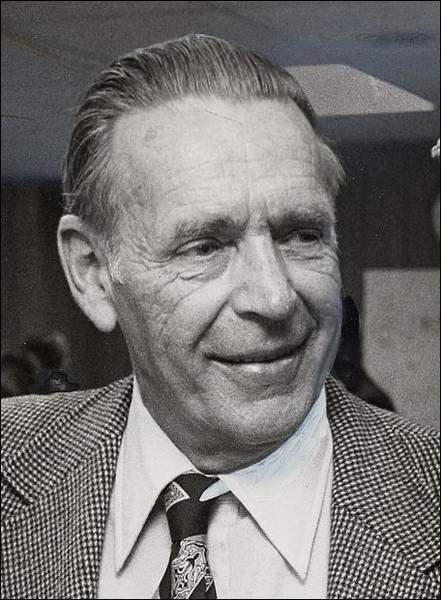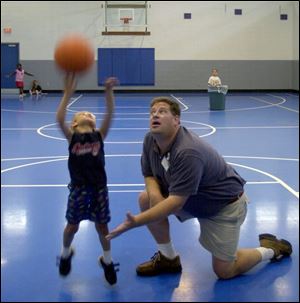
Family center toasts 100 years
8/3/2001
Mr. Densmore, a University of Toledo Hall of Fame football player who played professionally with the Cleveland Rams, had just returned from serving in the military during World War II when he was appointed to the position he would hold for 37 years.

Tim Yenrick, under whose direction the center has expanded greatly, shows Tyler Sarra, 7, how to shoot a basketball.
When the Rev. H.W. Hoover started a tent mission at East Broadway and the New York Central Railroad tracks on Aug. 4, 1901, no one thought the mission would last more than a few days.
Tomorrow morning, friends and staff of the East Toledo Family Center - the end result of Mr. Hoover's tent mission - will gather to toast the center's 100th anniversary, a feat many find hard to believe.
“It's remarkable,” said the Rev. Larry Michaels of Martin Luther Church and co-author of a history of the center, which offers social service and recreational programs for people aged 3 to 90. “The need was there when the first families came, and the need is still there.”
For 31,500 East Toledoans, the center perfectly supports and represents the city's most ethnically diverse and unified neighborhood.
“It was just a great place to learn to grow up,” said Edward Reiter, the senior chairman of Sky Financial Group in Bowling Green, who spent much of his youth at the center.

Mr. Densmore, a University of Toledo Hall of Fame football player who played professionally with the Cleveland Rams, had just returned from serving in the military during World War II when he was appointed to the position he would hold for 37 years.
“There's a certain brotherhood there. All of us learned to grow up in great diversity; we honor diversity a lot.”
Mr. Hoover likely would be impressed with those words. He and his wife, Nellie, immigrated to the United States from Ontario, Canada, in the late 1800s. Mr. Hoover attended the University of Chicago, became a Baptist minister, and moved to Toledo, where he became pastor of Memorial Baptist Church on Oak Street.
On a Sunday, 100 years ago tomorrow, Mr. Hoover set up his tent on the site of a factory owned by D. J. Nysewander to minister to people outside the church, most of them immigrant families.
It quickly became apparent to Mr. Hoover that these people needed more than religion. They needed to learn English, they required basic social services, and their children needed a place to play and receive guidance.
According to Mr. Michaels, the mission quickly evolved into an organized settlement, with Mr. Hoover, Mrs. Hoover, and their assistants working with the immigrants.
By 1902, through the generosity local businessmen, Mr. Hoover's group bought a vacated dump on Vinal Street near East Broadway.
The Hoovers resided in a large shed on the property until permanent housing was built. Several buildings were constructed, landscaping was added and, eventually, one of the city's first playgrounds.
The center was incorporated as the Ohio Neighborhood Institute, Mr. Michaels said, but was commonly called the Neighborhood House.
In the winter of 1908, the center faced its first serious test. A recession left many East Toledoans out of work and without money to buy food. Mrs. Hoover recruited local businessmen who chipped in food and other aid.
In the period leading up to World War I, as immigration increased, the center began offering English classes. About that time, before Oakdale school opened, elementary classes also were held at the center. By then, the center was offering a variety of sports for neighborhood children, along with numerous other activities.
Its importance to East Toledo can be measured by its 1916 attendance records, which show that more than 28,000 people participated in the center's activities, according to Mr. Michaels.
By 1927, the center had added an auditorium, a classroom, and a refectory, along with a residence house for the Hoovers. During the Depression, the center played a critical role in aiding East Toledo families and providing a gathering place during difficult times.
“In the midst of the general unhappiness, the Neighborhood House has striven to relieve the drab hopelessness of the situation,” wrote resident Isabel Toppin in 1930.
Mr. Hoover died in 1932. His wife carried on the center's work and eventually was replaced by their son, Harper Hoover and his wife, Mary Ann.
“It was a fine place to raise children; I took my two boys there every day,” said Elfrida Reiter Dunn, mother of Edward Reiter and a center volunteer in the 1930s.
In 1946, Warren Densmore became executive director. Mr. Densmore, a University of Toledo Hall of Fame football player who played professionally with the Cleveland Rams, had just returned from serving in the military during World War II when he was appointed to the position he would hold for 37 years.
Under Mr. Densmore's leadership, the center expanded its programs, forged relationships with other social service organizations, and in 1971 built a new center, called East Toledo Family Center, at its current location on Varland Avenue at East Broadway.
“He was a big factor in a lot of people's lives,” said former East Toledoan Bill Romp, vice president of sales for Habitec Security Systems, Toledo. “He gave us a lot of direction. He coached the kids. He was always there. He was a big influence on a lot of kids who did not have places to go.”
Mr. Densmore's widow, Lois Densmore, who moved to Roanoke, Va., in February, said she's not surprised by such comments.
“There wasn't anyone who hadn't anything but the highest respect for him. He enjoyed his work, and he was dedicated to helping the people there,” she said.
In honor of Mr. Densmore's contributions, the center's board named the building after him and each year holds a scholarship awards dinner and fund-raiser that also carries his name.
In the 1980s, the center survived a pair of financial crises that almost shut it down. The first, in 1980, occurred after the city, which became a major contributor in 1971, pulled its support. Outside funding was found. In 1989, the United Way threatened to withdraw $109,000 in funding - 75 percent of the center's budget - because agency officials were not pleased with the center's financial situation.
That fall the center's board hired 26-year-old Tim Yenrick as its executive director. Within six months, Mr. Yenrick and the center's board had righted the situation and United Way funding was restored. Nearly 13 years later, Mr. Yenrick remains at the helm.
“It was a challenge,” he said of the center's turnaround. “But I work for and with the best group you could ever work with.”
Under Mr. Yenrick's direction, which has been highly acclaimed by the center's alumni, the center has gone from serving 1,000 people a year to 10,000.
He has 22 full-time and about 45 part-time employees, and up to 400 volunteers participate in some center events, such as the annual summer picnic and fund-raising gala, held each April.
Programs have expanded, too. In conjunction with Toledo Public Schools, the center provides alternative classes for troubled fifth and sixth-grade students. Toledo police have a satellite office at the center. And the center offers numerous services for senior citizens, such as mobile meals, housekeeping services, and athletic programs.
“It's been a wonderful experience for my daughter,” said Jackie Wallace, whose 8-year-old daughter, Alexis Stock, is active in educational and sports activities at the center. “My daughter is from a diverse cultural background, and they really try to focus on that there.”